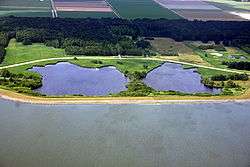Inundation of the Wieringermeer

On April 17, 1945, the German occupying forces inundated the polder Wieringermeer, the Netherlands.
Preparations
In the end of February or the beginning of March 1945, Dutch workers started to undermine the dike around the polder under German command. The location is near the farm of Beetstra, in the dike with the IJsselmeer.
.jpg)
Deep holes were dug in the dike both at the bottom and at the top of the dike. In these holes explosives would be put. The work was progressing slowly since none of the workers were motivated. In April, the work came to a complete stop.
On April 10, German officers came and inspected the work. New workers were sought and 25 to 50 people were taken from Schagen during a razzia to work on the digging. After a week, the holes were deep enough and explosives were installed. Each hole was loaded with 1000 kg. of explosives; unexploded bombs from British and American aircraft were used.
On 17 April at 12.15 am, the explosives were ignited. The 7,000 people in the Wieringermeer and the estimated 1000 to 2000 refugees had to leave the polder. Within 48 hours, the entire polder was full with water, with an average depth of 3.75 m.
References
J. J. Bosman and P. C. Bosman, De polder onder water, het verslag van de onderwaterzetting van de Wieringermeerpolder in 1945, Free Media, 1995